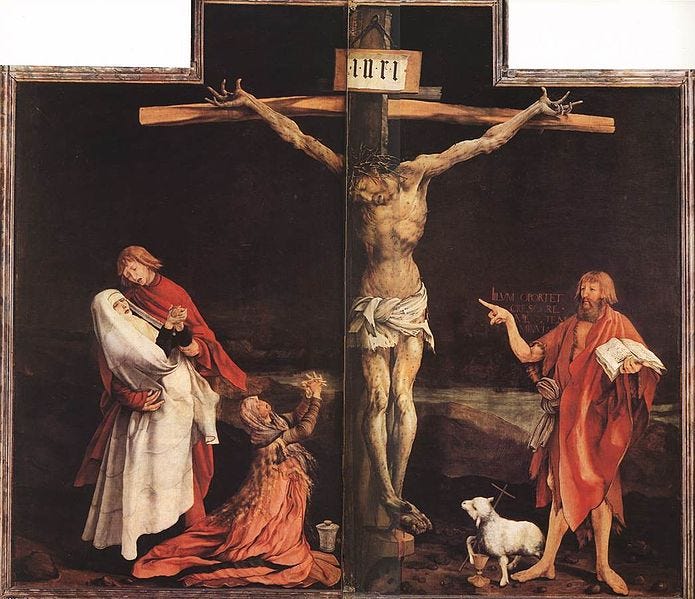The Long Bony Finger
"For I decided to know nothing among you except Jesus Christ, and him crucified."
1 Corinthians 2:1-2
When I came to you, brothers and sisters, I did not come proclaiming the mystery of God to you in lofty words or wisdom. For I decided to know nothing among you except Jesus Christ, and him crucified.
Matthias Grünewald was a German Renaissance painter of religious works known for his brutal depictions of realism. Among his various works, his most famous is the Issenheim Altarpiece depicting the crucifixion of Jesus. Grünewald was approached in the early 1500’s about creating the altarpiece for the Monastery of St. Anthony in Issenheim (North-Eastern France) and it took him and another German artist named Nikolaus of Haguenau four years to complete the altarpiece and it is widely considered Grünewald’s masterpiece.
At the time of creation, the monastery specialized in hospital work with a particular emphasis on caring for plague sufferers and those with various skin diseases. Grünewald specifically portrayed the crucified Christ with plague-type sores in order to help patients understand that Jesus shared their afflictions.
The altarpiece went largely unnoticed by the art world until the early 20th century when it became a focal point of veneration before and after the first World War. In short, the violence of the painting resonated with the violence of the war, and it began to truly enter the cultural consciousness. So much so that a young pastor-theologian by the name of Karl Barth discovered the painting in the summer of 1918 when he also finished his first manuscript of his Epistle to the Romans. Barth famously kept a copy of the painting above his desk throughout his ministry from his time as a preacher, through his professorial stints in Germany and Switzerland, until his death. He referred to the painting more than 50 times through his various writings, and it is the only piece of art so honored other than Mozart.
The painting itself displays an emaciated, wounded, and suffering Christ on the cross with various witnesses to the crucifixion including Mary the Mother of God, Mary Magdalene, John the Beloved, and (anachronistically) John the Baptist.
John the Baptist, of course, was not present at the crucifixion since he was beheaded by Herod earlier in the Gospel.
However, Barth always considered John the Baptist’s inclusion in the painting to be instructive for Christian preaching. John stands to the side of the cross, pointing a rather large and bony finger away from himself to Christ, with the scriptures opened in his other hand. The Christian preacher, therefore, does well to preach from the scriptures while pointing away from him/herself to the One in whom we live and move and have our being.
In other words, the painting continues the Pauline work of “knowing nothing among you except Jesus Christ, and him crucified.”
One of the things that differentiates the Catholic Church from the Protestant Church is the Protestant Church’s reticence to show Jesus on the cross. The Protestant Church’s emphasis on the resurrection of Jesus over and against his suffering has resulted in empty crosses in various sanctuaries. The emphasis on the resurrection is well put and yet, divorcing Christ from the cross results in a Christian symbol that carries little, in any, offense.
The crucifixion of Jesus is inherently scandalous! God dies on the cross! For us!
The season of Lent, for better or worse, is the great opportunity to come to grips with the scandal of the Cross. Lent, with its texts, prayers, and songs forces us to contend with the bewildering claim that the author of the cosmos knows our suffering because we worship the crucified God.
I remember a Good Friday from the past when I stood before the gathered congregation and encouraged everyone to stand and sing the hymn “Ah, Holy Jesus.” It’s a strange hymn in a minor key and we all suffered through it, but when the service ended a woman was waiting for me in the narthex and she said, “I am never coming back for a Good Friday Service ever again.”
I inquired as to what exactly upset her so much and she said, “It was that damn hymn. I don’t think we should spend so much time focusing on Jesus’ death, let alone sing about it. I don’t know about you, but I would never have crucified Jesus.”
Verse 2: “Who was the guilty? Who brought this upon thee? Alas, my treason, Jesus, hath undone thee! ’Twas I, Lord Jesus, I it was denied thee; I crucified thee.”
There is the innate desire within us to believe, had we been there, we would’ve been good little disciples and we would’ve stayed with Jesus till the end. However, we do well to remember that even the first disciples called by Jesus, the one upon whom Jesus said he would build his church, denied him and abandoned him in the end.
The lack of Jesus on crosses in the Protestant church sanitizes the crucifixion in a way that gets us off the hook for the death of God. But, the Lord will not allow us to get away with such arrogance. We can avoid all the hymns, and even all the symbols, but those who follow in the line of John the Baptist will continue to point their bony fingers to Jesus reminding us what we’ve done.
And yet, Paul decided to know nothing among the Corinthians except Jesus Christ and him crucified, because the cross reveals the great lengths to which God was and is willing to go for us. Or, as we say in the United Methodist Communion liturgy:
“Hear the Good News! Christ died for us while we were yet sinners; that proves God’s love toward us. In the name of Jesus Christ, you are forgiven! Glory to God! Amen.”





